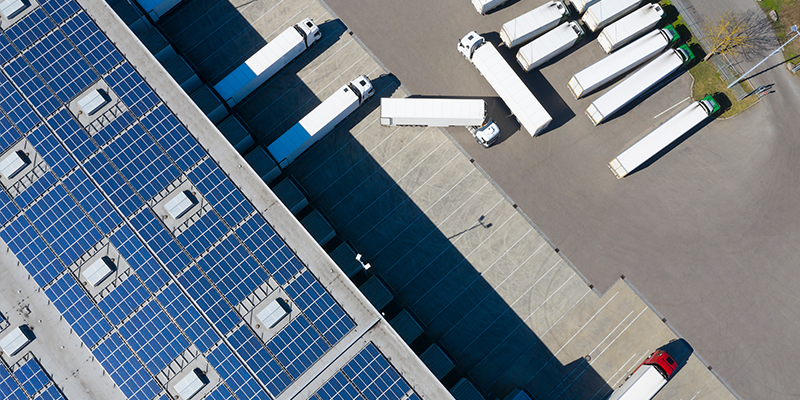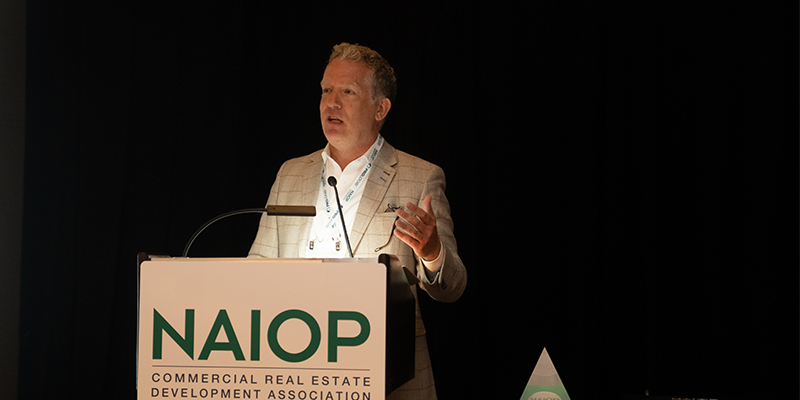Rooftop and community solar projects can advance sustainability and ESG objectives, unlock a new revenue stream, enhance community relations, and boost property values. At I.CON East this week, NAIOP New Jersey CEO Dan Kennedy moderated a panel of speakers including Matt Schlindwein, P.E., managing partner for Greek Real Estate Partners; Mark Schottinger, president at Solar Landscape; and Kat West, LEED AP, director of sustainability at Turner & Townsend, to explore the transformative potential of rooftop and community solar projects for the industrial real estate sector.
Schottinger was direct from the start: “If you’ve got a warehouse, I want to lease your roof.”
Solar power, historically, meant solar panels on the roof generated power that was used by whoever was in the building, with zero potential for scalability.
“Community solar allows for a building owner to lease an entire rooftop, pump the electricity into the power grid instead of the building, and [allow] the surrounding community to subscribe to receive that power at a discount,” Schlindwein explained. Residents can access savings without having to install solar panels on their own roofs.
Aside from collecting a roof lease payment, industrial building owners utilizing rooftop solar have the added benefit of engaging with the community in a meaningful way, providing solar to moderate- and low-income households.
“My first foray into rooftop solar was 10 years ago, and there were a lot of concerns, quite frankly,” said Schlindwein. Greek Real Estate Partners decided to take advantage of a federal tax grant that was available at the time and build solar arrays themselves, which the company still owns.
When the opportunity came around years later to partner with Solar Landscape, “I brought out the same list of questions and concerns I had the first time around, but this time there were more answers and information,” said Schlindwein.
West shared her approach when advising developers interested in rooftop solar. “We develop an energy model to see how much energy their building will require. Then we work to match that to whatever the clients’ sustainability goals are.” While many of her corporate clients’ sustainability programs allow for them to just purchase renewable energy certificates, “when you see a solar array that is powering a school, that’s much more tangible.”
Cost is a consideration, however. “I’ve never had a client that wants something to pay back in 15 years,” West said. “But in some cases, they don’t mind a longer payback because it gives them a degree of certainty what their energy costs will be.”
Kennedy asked the group who is leading the charge on rooftop solar: owners or tenants? “I don’t know any of our major institutional capital partners who don’t have ESG priorities,” said Schlindwein. They want to be able to tell their investors that they’re investing responsibly. “The tenant is interested, but the money behind it is even more interested,” he added.
West shared that she uses a pre-leasing checklist, and solar is always included. “That can be a make-or-break where your building is ranked – if there’s solar or not. So, if you’re looking to lease up quickly, that’s a consideration.”
“In New Jersey it’s almost become an assumption that we’ll put solar on the roof,” Schlindwein said. He added that Greek Real Estate Partners prioritizes having solar-ready roofs for their industrial projects.
A question came from the audience: Can solar be used as backup power source? It’s possible. If battery storage is part of the system, it can be used as a secondary source of power. “I know our company is looking into [secondary sources of power] as demands on the power grid increase,” said Schlindwein.
“The issues with the grid keep a lot of people up at night,” Schottinger agreed. “Regulators need to understand that this is tangible and beneficial. Every 500 megawatts (DC) of community solar capacity create about 4 million prevailing wage hours – it creates real job opportunities.”
“There are markets already that are mandating solar-ready roofs, if not mandating solar on the roof already,” said Schottinger. “When you lock in a 20-year lease now, you’ll pat yourself on the back when in 10 years there are mandates and you’re already compliant.”

This post is brought to you by JLL, the social media and conference blog sponsor of NAIOP’s I.CON East 2024. Learn more about JLL at www.us.jll.com or www.jll.ca.








